Hyperlinked Communities Reflection: Seattle’s Central Public Library
In February I had the opportunity to visit the Central Library in Seattle, which like some of the Scandinavian libraries we have been exploring stands out as a marvel of architecture and innovation. In reflecting on the design and mission of the Seattle Public Library’s Central Library, I’ve been considering how it exemplifies the principles for the Hyperlinked Library we are developing in this class. Additionally, I want to refer to the IFLA’s Public Library Service Guidelines, particularly the first chapter on the purpose of the public library that frames the library as a democratic, innovative, and user-centered space. The guidelines emphasize that “the modern library is much more than a collection of books: it is a place for learning, cultural engagement, and community interaction” (IFLA, 2010). The Central Library, with its glass-and-metal lattice and soaring atrium floors, doesn’t just embody this vision, but amplifies it through its physical structure and programming philosophy.
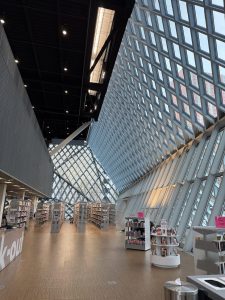
Seattle’s Central Library is stunning architecturally, but the value of its striking design goes beyond aesthetics. The building’s transparency, being composed of nearly 10,000 windows, signals its openness to the public, both literally and symbolically. From the ground up, the space is designed to reflect public ownership. With features like the Red Floor’s meeting rooms and the open-plan Living Room on the third floor, the library invites a kind of civic visibility that aligns with IFLA’s call for libraries to be “public forums for democratic participation.” It feels significant that the building doesn’t retreat from its downtown surroundings but instead asserts itself as a central, accessible node in the urban fabric. Opposite of the “outside-in” transparency when viewed from the outside, from within the space of the library you can look out at the city around you, which serves as a constant reminder of the reality of the community around it and reinforces that it is just one part within the wider community of the city itself.
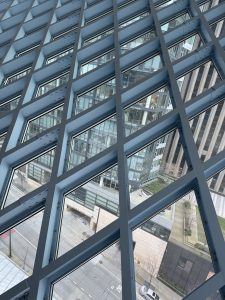
One of the clearest ways the Central Library functions as a “third space”, as we’ve discussed in this class is through how its spatial arrangements are intentionally layered to support both individual and collective use. On the first floor, young children and families engage with toys, sensory kits, and early literacy programming in the Children’s Center. A few floors up, teenagers find dedicated services in the Teen Center, including college prep help and job application support. Meanwhile, on the 10th floor, the Reading Room and the Seattle Collection offer contemplative views of the city and deep access to local history and identity. This multi-generational, multipurpose design feels responsive not just to different user needs, but also to different temporal needs, whether one is dropping in for a hold, pausing for a quiet afternoon, or returning weekly to engage in an ongoing library program. Exploring the library on foot, these spaces certainly feel different, and they invite different types and degrees of engagement.
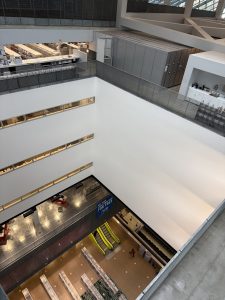
These uses of space echo the IFLA guidelines’ assertion that libraries should serve as “centers for lifelong learning,” offering both structured programming and open-ended exploration. The Book Spiral is a literal and metaphorical manifestation of this, winding the nonfiction collection continuously through four floors without interruption, allowing patrons to wander by subject in a seamless experience that challenges traditional boundaries of classification. Visiting it, I was able to experience directly the way that this imaginative use of space manifests itself psychologically. These nonfiction stacks can often be an intimidating sprawl, but by presenting it this way they unfold naturally in front of you and invite you to explore them on foot. Connected to these collections are numerous places for work and study, and there were many people using the space in this manner as well. The library also demonstrates a forward-thinking approach to technology, not only in its services but in how it integrates technology into public life. The fifth-floor Mixing Chamber acts as an informal learning lab, providing access to computers, printers, and staff support for digital skills. The LEAP Lab goes even further in its commitment to equitable access by offering assistive technology to patrons with visual impairments. It’s not just that these services exist, it’s that they are integrated in such a way that disabled patrons can participate meaningfully and independently in library life. Throughout the library, technology and services are placed physically in ways that promote accessibility to all patrons.
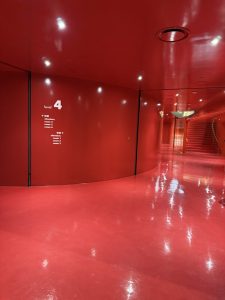
Beyond equipment and infrastructure, the Central Library is deeply invested in human-centered innovation. The over 1,000 programs it hosted in 2024 including civic services, job resources, tax assistance, author talks, and arts programming that illustrate a library that is not merely reacting to community needs but proactively shaping civic culture. I was especially struck by how the space makes room for play, expression, and informal creativity, from the octopus mural emerging from the third-floor shelves to the tactile poetry floor of raised type designed by Ann Hamilton. The Red Floor, while practical in housing the meeting rooms, is also an attraction all on its own. These features act not as distractions from the library’s mission but as extensions of it. They build comfort, curiosity, and surprise, qualities that sustain engagement over time and bring new people in the door.
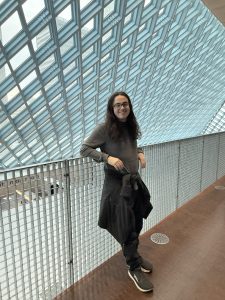
International Federation of Library Associations and Institutions. (2010). IFLA public library service guidelines (2nd ed.). IFLA. https://repository.ifla.org/items/83753461-738d-4a36-a18e-60a7ae8e6c64
2 Comments
Ali Ongaro
Hi Ian, thanks for sharing your experience with the Seattle Public Library. I always love reading about visits to “destination libraries,” this one seems like it would be an awesome visit. Something that resonated with me in your post was when you mentioned that this library is “multi-generational.” I think it’s important for libraries to feel like a welcome place to all ages. With this library’s transparent space design, it allows for people of different ages to see eachother and potentially interact which I think sets up these patrons to build community outside of their norm. I enjoyed your post!
Michael Stephens
@iant I really appreciate your take on what the spaces in SPL are doing. The idea that they are extensions of the mission of the library is very cool. I toured it many years ago and vividly recall the red floor and how it made me feel. The whole building was like nothing I had ever seen before.